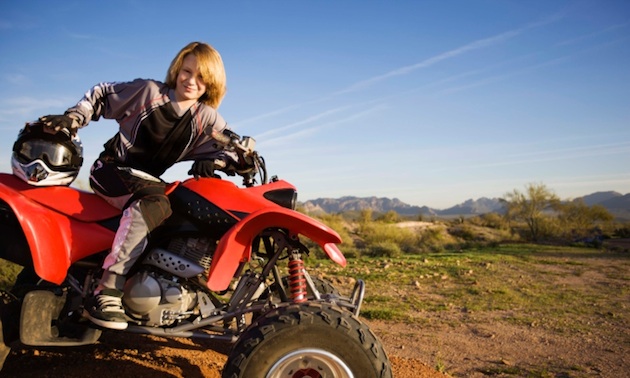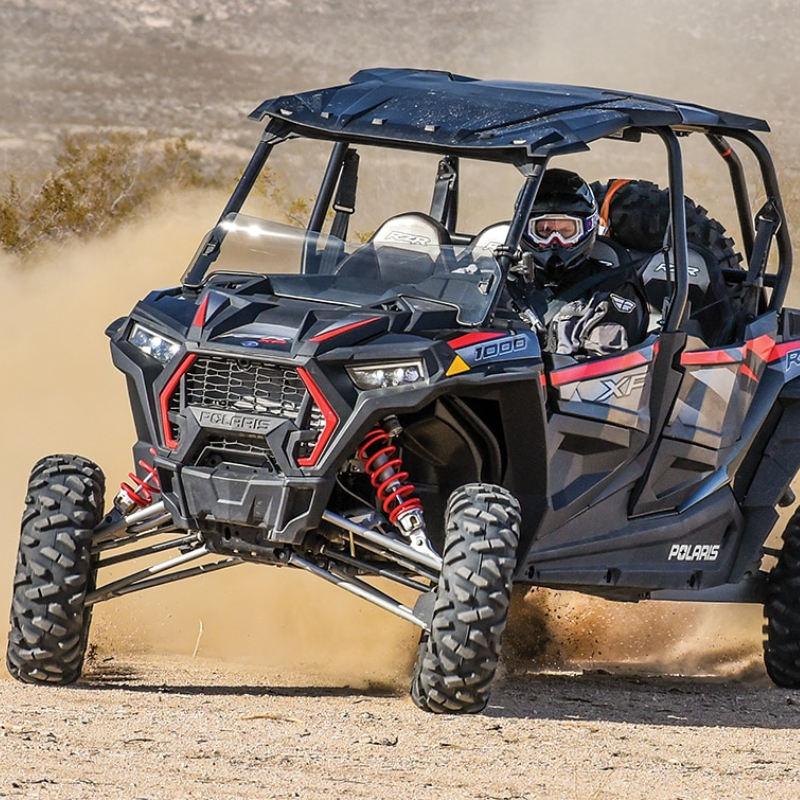As people gear up for ATV riding, John Meed of the Saskatchewan All-Terrain Vehicle Association (SATVA) has some advice—wear your helmet!
“Getting out on your ATV and enjoying the nice weather is a great recreational activity, but there are also hazards that accompany this pastime,” said Meed. “Wearing a helmet is the first step in making ATV safety a priority for riders. It’s such a simple thing to do, yet many riders still refuse to wear a helmet, placing themselves at greater risk for serious injury and even death.”
In 2013 eight people were killed and another 47 were injured in ATV accidents in Saskatchewan, the highest mortality rate and second highest injury rate in a year since 2000. ATVs are especially dangerous when used by children and young teens because they lack the knowledge, physical size, strength and cognitive and motor skills to operate them safely. Recent research indicates that wearing a helmet while riding an ATV reduces an individual’s risk of death by 42 per cent and of suffering a head injury by 64 per cent. Head and spinal cord injuries are among the most common injuries incurred by ATV users.
“Helmets are the single most effective means of preventing head injuries that result in death or permanent disability,” said Meed, SATVA’s general manager. “The helmet you put on your head may be the only thing responsible for saving your life when your own judgment, skill and luck have failed to keep you safe. That is why choosing the right helmet is so important.”
Many reasons to wear a helmet
There are numerous other reasons to wear a helmet. They can help you hear other sounds better since they reduce ambient wind noise. A full-face helmet can keep you from being distracted, especially if you are stuck by insects or other objects in the face. Helmets can reduce fatigue from the wind, which in turn keeps you more alert. If you wear a brightly-coloured helmet, it is easier for other offroaders to see and avoid you.
Despite these benefits, some riders still feel that they don’t need helmets—helmets will negatively impact their experience, or wearing one simply isn’t cool. Meed said the truth is that today’s helmets are very comfortable and lightweight, and they provide the rider with plenty of protection from the elements. And, of course, a helmet can save your life.
Helmet tips
There are three basic types of ATV helmets: full face, open face and off-road. Full-face helmets completely cover your face and feature moldings that extend to the chin and mouth for extra protection. Off-road helmets also completely cover the face, but provide more ventilation. Open face helmets only cover the head and chin, leaving the rest of the face exposed. These helmets are usually used by those who use their quads for work such as ranching and oil field maintenance, or for outdoor recreation activities such as hunting and fishing.
Meed suggests that when you buy a helmet make sure that it has the proper fit. It should be securely fastened and snug, but not so tight that the helmet can’t move. You should not be able to insert a finger between your forehead and the helmet lining. The padding of a full-face helmet should press lightly against your cheeks, but still be loose enough to enable you to insert a finger or two.
“While wearing your helmet, try to rotate it without turning your head,” said Meed. “If the helmet turns enough to interfere with your vision, then it is too loose and you should try the next size down. If that one is too tight, you might want to consider a different brand.”
Another tip is to try jumping up and down and leaning from side to side to see how easily the helmet moves.
The weight of a helmet is another consideration. Try wearing the helmet for 10 to 15 minutes and see if it places too much weight on your head. If it seems too heavy, then choose another, since the wrong helmet may prevent you from seeing clearly in all directions.
There are other features you should consider as well. See if the air vents can be opened or closed for hot or cold weather. You may also want a visor that is adjustable to your style.
Replace older or impacted helmets
If you have an older helmet, double check how long the manufacturer recommends to keep it. Most helmets deteriorate with age and usually have to be replaced after five years. This is because glue, resin and other materials in the helmet eventually break down and affect the interior liner. Hair oils and cosmetics can also impact helmet durability, as does normal wear and tear.
“A helmet is only good for one impact,” said Meed. “If you dent or crack your helmet, you must get a replacement helmet right away. Helmets are made in such a fashion that a blow will impact their integrity, even if it is not apparent while viewing. ”
After you’ve purchased your helmet, it is important to properly maintain it. Many helmets feature removable liners that can be thrown into the washing machine. To be on the safe side, let it air dry rather than using the dryer. If the liner isn’t removable, clean it with soap and water.
ATV use is increasing
Meed said that ATV use continues to increase in Saskatchewan, which makes it even more important for people to wear their helmets. There are about 8,000 quad style and side-by-side ATVs sold each year in the province.
“Accidents are never planned,” said Meed. “Wearing a helmet is one of the best ways to protect yourself in the event of an accident, so you don’t become an ATV statistic.”
SATVA was formed in 2006 to unite ATV clubs and users into a single voice to promote the safe and responsible use of ATVs in Saskatchewan.
For more information contact John Meed at 1-855-297-2882 or email [email protected]








Comments